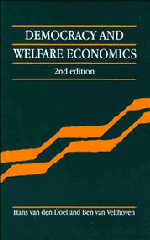7 - The political process
Published online by Cambridge University Press: 03 May 2011
Summary
The political process as a number of production stages
Whereas chapters 3 to 6 dealt with separate stages of the political process, this chapter will consider the political process as a whole. In a political process the individual voter's demands on, and his support for, the government are converted into government policy, of which, in turn, certain effects are experienced by the individual voter. In our opinion, four methods of decision-making are applied in the course of this process of conversion: negotiation, majority decision, representation, and implementation. We have analysed these four methods of decision-making as independent decision-making models, i.e. as a negotiations democracy, a referendum democracy, a representative democracy and an implementation bureaucracy.
A negotiations democracy is the logical basis of every democracy. The basic pattern is split up into the other three decision-making models. In a negotiations democracy each individual is both supplier and demander. Using the method, described by Lindahl, of simultaneous negotiations the individuals reach an agreement. Then they implement this agreement.
A referendum democracy specialises in making binding decisions. Negotiations and decision-making are separated. Decision-making is not by way of a contract but by way of taking enforceable majority decisions.
In a representative democracy demanders and suppliers are separated. The demanders are private citizens, in their quality of voters or organised in pressure groups. The suppliers have an official function, e.g. elected representatives (‘politicians’) or bureaucrats.
- Type
- Chapter
- Information
- Democracy and Welfare Economics , pp. 175 - 184Publisher: Cambridge University PressPrint publication year: 1993



